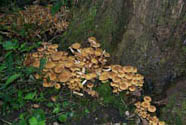 Key to Gilled Mushrooms Key
Key to Gilled Mushrooms KeyThis is a key to gilled mushrooms, that is, mushrooms having a definite cap with a fertile surface consisting of gills. The fruiting body usually also has a stem, although that may be lateral or absent (usually, then, the mushroom is growing from wood). You can use this key to identify mushrooms that you find.
 Agaricales Order
Agaricales OrderFruiting body containing fibers (usually in the stalk)
 White Spored Suborder
White Spored SuborderSpore print "light-colored": white or buff, sometimes tinged with pink or tan. Greenish and (except for the Russulales) yellow spore prints also go here
Stalk fibrous, not fracturing like a piece of chalk
 Tricholomataceae Family
Tricholomataceae FamilyNone of the special features distinguishing the other white-spored genera:
Gills not free, as in the Lepiotas and Amanitas
Basidia not extra-long, as in the Hygrophoraceae
Spores smooth, except for Lentinellus
 Lignicolous Trich Subfamily
Lignicolous Trich SubfamilyGrowing on trees or dead wood, leaves, or sticks, or organic debris, often in moss
 Normal LignoTrich Tribe
Normal LignoTrich TribeShaped like a “normal mushroom”
Small and fragile to medium-sized, except for one large, grey-capped species
Small Ligno Trich Subtribe
Diagnosis
- Fruiting body small: cap up to 1 1/4" across (and most clearly smaller than that)
Narrow down your identification:
Baeospora Genus- Fruiting body usually possessing purple pigments (showing up as lilac to lavender) which fade with age
-
Flesh buff to lilac, inamyloid
-
Gills crowded to very crowded
-
Stem with long hairs at the base
Callistosporium Genus
Clitocybula Genus- Grows in very dense clusters on wood, which is sometimes very decayed
-
Cap margin uplifted in age, but usually without losing central umbo
 Conicolous Trich SemiTribe
Conicolous Trich SemiTribe- Growing only on pine cones or other woody fruits (magnolia cones, tulip-tree fruits)
-
Cap usually less than 3/4" across
 Flammulina Genus
Flammulina Genus- The genus is defined by a sticky cap, and prominent pleurocystidia.
-
It tends to grow directly on wood, and is a little bit bigger (cap 3/4" - 1.5") than the other small white-spored things that fruit on wood
 Marasmiellus Genus
Marasmiellus Genus- Cap usually white; convex becoming flat, plicate in maturity; often thin to the point of being translucent
-
Gills usually very, very distant ("few and far between" says Arora (1986) ), often forking or with cross-veins
-
Stem thin but not wiry; often much darker than cap, at least towards the base in maturity
-
Often with wiry rhizomorphs
 Marasmius Genus
Marasmius Genus- Basically, the members of this genus can look like members of any other SmallLignoTrich.
-
You might want to check here first if your mushroom is very small, has a thin, wiry stem or is revenant. Or if it looks like the picture. :-)
-
Else, check this genus if you can't find your mushroom anywhere else
Micromphale Genus
 Mycena Genus
Mycena Genus- Cap bell-shaped, conical, or either of those with an umbo; margin never incurved; usually some shade of grey or brown, but purplish in one unusually large species.
-
Stem thin; either very fragile or very tough
-
Some species have a colored juice that can be squeezed out of the end of the stem
-
No rhizomorphs
 Omphalinoids SemiTribe
Omphalinoids SemiTribe- Mature fruiting body with an omphalos, never bell-shaped or conical. Never even flat except when very young.
-
Usually more colorful than the other choices
-
Often growing in or among a lichen
 Panellus Genus
Panellus Genus
Resinomycena Genus
 Rickenella Genus
Rickenella Genus- Very small, orangish, growing in moss
-
Spores inamyloid
-
Special cystidia






 Key to Gilled Mushrooms Key
Key to Gilled Mushrooms Key Agaricales Order
Agaricales Order White Spored Suborder
White Spored Suborder Tricholomataceae Family
Tricholomataceae Family Lignicolous Trich Subfamily
Lignicolous Trich Subfamily Normal LignoTrich Tribe
Normal LignoTrich Tribe Conicolous Trich SemiTribe
Conicolous Trich SemiTribe Flammulina Genus
Flammulina Genus Marasmiellus Genus
Marasmiellus Genus Marasmius Genus
Marasmius Genus Omphalinoids SemiTribe
Omphalinoids SemiTribe Panellus Genus
Panellus Genus Rickenella Genus
Rickenella Genus




